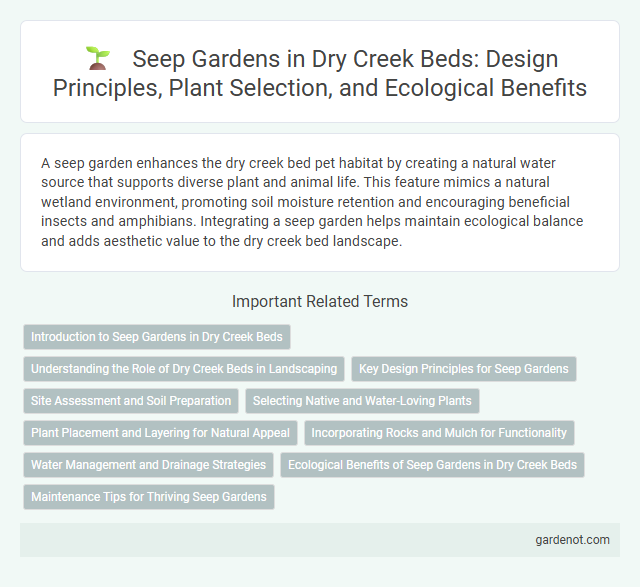A seep garden enhances the dry creek bed pet habitat by creating a natural water source that supports diverse plant and animal life. This feature mimics a natural wetland environment, promoting soil moisture retention and encouraging beneficial insects and amphibians. Integrating a seep garden helps maintain ecological balance and adds aesthetic value to the dry creek bed landscape.
Introduction to Seep Gardens in Dry Creek Beds
Seep gardens in dry creek beds create unique microhabitats by harnessing naturally occurring groundwater seepage to support moisture-loving plants in otherwise arid conditions. These specialized gardens enhance biodiversity by fostering native species such as ferns, rushes, and sedges that thrive in the cool, wet environment provided by the seepage. Integrating seep gardens into dry creek bed landscapes promotes ecological balance, erosion control, and water filtration.
Understanding the Role of Dry Creek Beds in Landscaping
Dry creek beds serve as effective seep gardens by directing and managing water flow, promoting natural infiltration and reducing erosion in landscaped areas. Incorporating native plants alongside porous materials enhances soil moisture retention and supports local biodiversity within these dry creek features. Properly designed dry creek beds balance aesthetics with functional water management, making them valuable assets in sustainable landscaping.
Key Design Principles for Seep Gardens
Seep gardens rely on careful site assessment to identify natural water flow and soil saturation, ensuring optimal moisture retention for native plant species. Incorporating layered soil profiles and strategic plant selection promotes efficient water filtration and habitat creation. Emphasizing slow water movement and soil stabilization reduces erosion while supporting diverse wetland ecosystems.
Site Assessment and Soil Preparation
Site assessment for a seep garden in a dry creek bed involves evaluating soil permeability, drainage patterns, and water flow to ensure sustainable moisture retention. Soil preparation requires amending native soil with organic matter and fine-textured materials to improve water-holding capacity and support native moisture-loving plant species. Proper grading and removal of debris help direct seepage effectively, preventing erosion and promoting healthy root systems.
Selecting Native and Water-Loving Plants
Selecting native and water-loving plants for a seep garden enhances its ecological balance and water retention capabilities. Species such as Carex stricta, Juncus effusus, and Lobelia cardinalis thrive in moist, seepage-prone soils, promoting biodiversity and soil stabilization. Incorporating these plants supports local wildlife while maintaining the natural hydrology of the dry creek bed environment.
Plant Placement and Layering for Natural Appeal
Plant placement in a seep garden within a dry creek bed emphasizes strategic layering to mimic natural water flow patterns. Use moisture-loving plants near the seep, gradually transitioning to drought-tolerant species along the dry edges, creating a seamless gradient that enhances visual depth and ecological function. Careful grouping of plants with varying heights and textures promotes biodiversity and improves soil stability in the seep environment.
Incorporating Rocks and Mulch for Functionality
Seep gardens benefit from incorporating rocks and mulch to enhance water retention and soil stabilization in dry creek beds. Strategically placed rocks create natural barriers that slow water flow, reducing erosion and promoting infiltration. Mulch enriches the soil, maintains moisture levels, and supports plant growth, increasing the garden's overall resilience and ecological function.
Water Management and Drainage Strategies
Seep garden design utilizes natural water management techniques by channeling groundwater and surface runoff through porous soil and native vegetation, enhancing infiltration while reducing erosion. This strategy supports effective drainage by slowing water flow, promoting sediment deposition, and improving water quality through phytoremediation. Integrating dry creek bed elements further optimizes stormwater capture and distribution, preventing localized flooding and sustaining healthy riparian ecosystems.
Ecological Benefits of Seep Gardens in Dry Creek Beds
Seep gardens in dry creek beds enhance groundwater recharge by slowing water flow and increasing infiltration, reducing erosion and sediment runoff. These gardens support diverse plant and wildlife habitats, promoting biodiversity and stabilizing the creek bed ecosystem. Native vegetation in seep gardens also improves water quality by filtering pollutants and providing shade to maintain cooler water temperatures.
Maintenance Tips for Thriving Seep Gardens
Regularly monitor soil moisture levels to maintain the delicate balance required for seep gardens, ensuring the substrate remains consistently damp without waterlogging. Remove invasive weeds and debris to promote healthy plant growth and prevent competition for nutrients in the moist microhabitat. Implement seasonal pruning of native riparian plants to encourage vigorous growth and enhance the natural filtration properties of the seep garden ecosystem.
Seep garden Infographic

 gardenot.com
gardenot.com